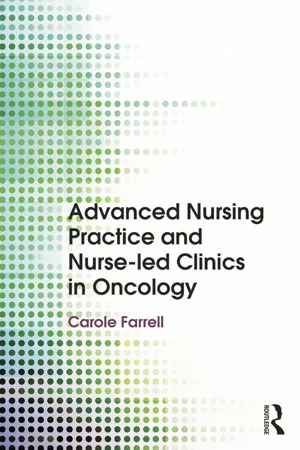
- 180 pages
- English
- ePUB (mobile friendly)
- Available on iOS & Android
Advanced Nursing Practice and Nurse-led Clinics in Oncology
About This Book
Over the past ten years there has been a dramatic increase in new nursing roles and nurse-led clinics within oncology. This unique handbook is a comprehensive companion for nurses studying and practising at an advanced level in this emerging field.
This text outlines and discusses roles, responsibilities and skills related to advanced practice in oncology nursing – including leadership, communication skills and prescribing – linking throughout to the implications for clinical practice. It then provides a step-by-step guide to setting up and developing nurse-led clinics, looking in more detail at clinics focusing on surgery, chemotherapy, radiotherapy, clinical trials and follow ups, and providing an in-depth case example of a clinic set up for adjuvant Herceptin use.
Practical, relevant and underpinned by current legislation, Advanced Nursing Practice and Nurse-led Clinics in Oncology is an invaluable resource for oncology nurses.
Frequently asked questions
Chapter 1
Nursing developments and policy influences
Defining nursing
- The tasks or procedures
- The nature of nursing care (for example skilled, compassionate, holistic)
- The functions of nursing care (for example, listening, assessing, monitoring) (DalPezzo, 2009)
Nursing models
Nurse theorist | Name of model | Main concepts |
|---|---|---|
Florence Nightingale (1859) | Environmental theory | • Unsanitary conditions pose a health hazard. • Nursing can provide fresh air, warmth, cleanliness, good diet, quiet to facilitate reparative process. • External influences can prevent or contribute to disease or death. |
Hildegard Peplau (1952) | Interpersonal relations model | • The person is a developing organism, tries to reduce anxiety caused by needs, lives in a stable equilibrium. • Based on psychodynamic nursing. • Uses an understanding of one’s own behaviour to help others identify their difficulties. • Nursing is a significant, therapeutic, interpersonal process that functions cooperatively with others to make health possible, and involves problem-solving. |
Ida Orlando (1961) | Deliberative nursing process | • The deliberative nursing process is set in motion by the patient’s behaviour. • All behaviour may represent a cry for help. Patient’s behaviour can be verbal or nonverbal. • The nurse reacts to patient’s behaviour and forms basis for determining nurse’s acts. • Nurses’ actions should be deliberative, rather than automatic. • Deliberative actions explore the meaning and relevance of an action. |
Dorothy Johnson (1980) | Behavioural systems model | • The person is a behavioural system comprised of subsystems constantly trying to maintain a steady state. • Constancy is maintained through biological, psychological, and sociological factors. • A steady state is maintained through adjusting and adapting to internal and external forces. • Nursing is an external regulatory force that is indicated only when there is instability. |
Dorothea Orem (1991) | Self-care model | • Self-care comprises those activities performed independently by an individual to promote and maintain person well-being. • Self-care deficit occurs when the person cannot carry out self-care. • The nurse then meets the self-care needs by acting or doing for; guiding, teaching, supporting, or providing the environment to promote patient’s ability. • Wholly compensatory nursing system – patient dependent. • Partially compensatory – patient can meet some needs but needs nursing assistance. • Supportive educative – patient can meet self-care requisites, but needs assistance with decision making or knowledge. |
Betty Neuman (1982) | Health care systems model | • The person is a complete system, with interrelated parts. • Maintains balance and harmony between internal and external environment by adjusting to stress and defending against tension-producing stimuli. • Nursing interventions strengthen flexible lines of defence, strengthen resistance to stressors, and maintain adaptation. |
Sister Calista Roy (1980) | Adaptation model | • The person is an open adaptive system with input (stimuli), who adapts by processes or control mechanisms (throughput). • The output can be either adaptive responses or ineffective responses. |
Roper, Logan, Tierney (1980) | Activities of daily living model | • The patient is assessed on their ability to perform the 12 activities of daily living. • The goals of the care plan are agreed between patient and nurse, then evaluated. • 5 dimensions: physiological, psychological, socio-cultural, politico-economical, environmental. |
Maslow (1970) | Hierarchy of needs model | • A 5-stage model based on a person’s needs, placed in a hierarchy. • Stages go from basic (physiological) needs to safety needs, social needs, and esteem needs, with self-actualisation being the highest level. • Later expanded to an 8-stage model to include cognitive and aesthetic needs, with transcendence needs (helping others to achieve) at the top. |
Patricia Benner (1984) | From novice to expert model | • Describes 5 levels of nursing experience and developed exemplars and paradigm cases to illustrate each level. • Levels reflect movement from reliance on past abstract principles to the use of past concrete experience as paradigms, and change in perception of situation as a complete whole in which certain parts are relevant. |
- A set of beliefs and values
- A statement of the intended goal
- The knowledge and skills required (Pearson et al., 1996)
- Optimum health Ill health
- Independence Dependence
- Adaptation Maladaptation
- Self-care Reliance on others
Table of contents
- Cover
- Title
- Copyright
- Dedication
- Table of contents
- List of tables and figures
- Preface
- List of contributors
- Introduction
- 1 Nursing developments and policy influences
- 2 The changing face of oncology nursing
- 3 Advanced nursing practice and clinical leadership
- 4 Autonomy: implications for oncology nursing
- 5 Non-medical prescribing
- 6 Compassionate and effective communication: key skills and principles
- 7 Developing and evaluating nurse-led clinics
- 8 The nature of nurse-led clinics in oncology
- 9 Nurse-led pathway for patients with HER2 positive breast cancer receiving Trastuzumab (Herceptin)
- Index